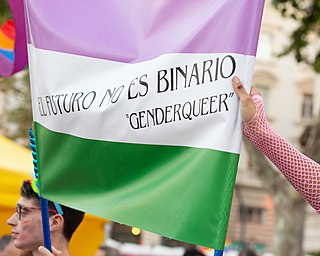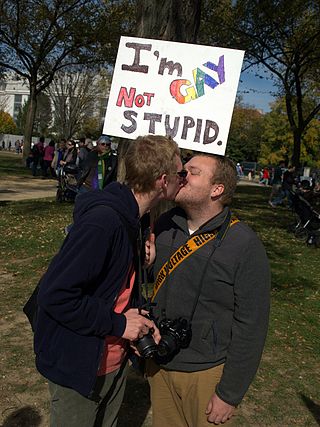Related Research Articles
Singular they, along with its inflected or derivative forms, them, their, theirs, and themselves, is a gender-neutral third-person pronoun. It typically occurs with an indeterminate antecedent, in sentences such as:
Womyn is one of several alternative political spellings of the English word women, used by some feminists. There are other spellings, including womban or womon (singular), and wombyn or wimmin (plural). Some writers who use such alternative spellings, avoiding the suffix "-man" or "-men", see them as an expression of female independence and a repudiation of traditions that define women by reference to a male norm. Recently, the term womxn has been used by intersectional feminists to indicate the same ideas while foregrounding or more explicitly including transgender women and women of color.

Gender includes the social, psychological, cultural and behavioral aspects of being a man, woman, or other gender identity. Depending on the context, this may include sex-based social structures and gender expression. Most cultures use a gender binary, in which gender is divided into two categories, and people are considered part of one or the other ; those who are outside these groups may fall under the umbrella term non-binary. Some societies have specific genders besides "man" and "woman", such as the hijras of South Asia; these are often referred to as third genders. Most scholars agree that gender is a central characteristic for social organization.
Cisgender individuals have a gender identity that corresponds to their sex assigned at birth. The word cisgender is the antonym of transgender. The prefix cis- is Latin and means on this side of. The term cisgender was coined in 1994 and entered into dictionaries starting in 2015 as a result of changes in social discourse about gender. The term has been and continues to be controversial and subject to critique.
Gender-neutral language is language that avoids assumptions about the social gender or biological sex of people referred to in speech or writing. In contrast to most other Indo-European languages, English does not retain grammatical gender and most of its nouns, adjectives and pronouns are therefore not gender-specific. In most other Indo-European languages, nouns are grammatically masculine or grammatically feminine, or sometimes grammatically neuter, regardless of the actual gender of the referent.
A third-person pronoun is a pronoun that refers to an entity other than the speaker or listener. Some languages with gender-specific pronouns have them as part of a grammatical gender system, a system of agreement where most or all nouns have a value for this grammatical category. A few languages with gender-specific pronouns, such as English, Afrikaans, Defaka, Khmu, Malayalam, Tamil, and Yazgulyam, lack grammatical gender; in such languages, gender usually adheres to "natural gender", which is often based on biological sex. Other languages, including most Austronesian languages, lack gender distinctions in personal pronouns entirely, as well as any system of grammatical gender.
Third gender is a concept in which individuals are categorized, either by themselves or by society, as neither a man or woman. It is also a social category present in societies that recognize three or more genders. The term third is usually understood to mean "other", though some anthropologists and sociologists have described fourth and fifth genders.

Non-binary and genderqueer are umbrella terms for gender identities that are not solely male or female. Non-binary identities often fall under the transgender umbrella since non-binary people typically identify with a gender that is different from the sex assigned to them at birth, though some non-binary people do not consider themselves transgender.
The word lady is a term for a girl or woman, with various connotations. Once used to describe only women of a high social class or status, the equivalent of lord, now it may refer to any adult woman, as gentleman can be used for men. Informal use is sometimes euphemistic.

A drawing room is a room in a house where visitors may be entertained, and an alternative name for a living room. The name is derived from the 16th-century terms withdrawing room and withdrawing chamber, which remained in use through the 17th century, and made their first written appearance in 1642. In a large 16th- to early 18th-century English house, a withdrawing room was a room to which the owner of the house, his wife, or a distinguished guest who was occupying one of the main apartments in the house could "withdraw" for more privacy. It was often off the great chamber and usually led to a formal, or "state" bedroom.

In the English language, an honorific is a form of address conveying esteem, courtesy or respect. These can be titles prefixing a person's name, e.g.: Mr, Mrs, Miss, Ms, Sir, Dame, Dr, Cllr, Lady, or Lord, or other titles or positions that can appear as a form of address without the person's name, as in Mr President, General, Captain, Father, Doctor, or Earl.

Terms used to describe homosexuality have gone through many changes since the emergence of the first terms in the mid-19th century. In English, some terms in widespread use have been sodomite, Achillean, Sapphic, Uranian, homophile, lesbian, gay, effeminate, queer, homoaffective, and same-gender attracted. Some of these words are specific to women, some to men, and some can be used of either. Gay people may also be identified under the umbrella terms LGBT.
A salutation is a greeting used in a letter or other communication. Salutations can be formal or informal. The most common form of salutation in an English letter includes the recipient's given name or title. For each style of salutation there is an accompanying style of complimentary close, known as valediction. Examples of non-written salutations are bowing, waving, or even addressing somebody by their name. A salutation can be interpreted as a form of a signal in which the receiver of the salutation is being acknowledged, respected or thanked. Another simple but very common example of a salutation is a military salute. By saluting another rank, that person is signalling or showing his or her acknowledgement of the importance or significance of that person and his or her rank. Some greetings are considered vulgar, others "rude" and others "polite".
The gender binary is the classification of gender into two distinct forms of masculine and feminine, whether by social system, cultural belief, or both simultaneously. Most cultures use a gender binary, having two genders.
While in ordinary speech, the terms sex and gender are often used interchangeably, in contemporary academic literature the terms often have distinct meanings, especially when referring to people. Sex generally refers to an organism's biological sex, while gender usually refers to either social roles typically associated with the sex of a person or personal identification of one's own gender based on an internal awareness. Most contemporary social scientists, behavioral scientists and biologists, many legal systems and government bodies, and intergovernmental agencies such as the WHO make a distinction between gender and sex.
Gender-neutral language or gender-inclusive language is language that avoids reference towards a particular sex or gender. In English, this includes use of nouns that are not gender-specific to refer to roles or professions, formation of phrases in a coequal manner, and discontinuing the collective use of male or female terms. For example, the words policeman and stewardess are gender-specific job titles; the corresponding gender-neutral terms are police officer and flight attendant. Other gender-specific terms, such as actor and actress, may be replaced by the originally male term; for example, actor used regardless of gender. Some terms, such as chairman, that contain the component -man but have traditionally been used to refer to persons regardless of sex are now seen by some as gender-specific. An example of forming phrases in a coequal manner would be using husband and wife instead of man and wife. Examples of discontinuing the collective use of terms in English when referring to those with unknown or indeterminate gender as singular they, and using humans, people, or humankind, instead of man or mankind.

Gender neutrality in languages with grammatical gender is the usage of wording that is balanced in its treatment of the genders in a non-grammatical sense. For example, advocates of gender-neutral language challenge the traditional use of masculine nouns and pronouns when referring to two or more genders or to a person of an unknown gender in most Indo-European and Afro-Asiatic languages. This stance is often inspired by feminist ideas about gender equality. Gender neutrality is also used colloquially when one wishes to be inclusive of people who identify as non-binary genders or as genderless.

A cuckold is the husband of an adulterous wife; the wife of an adulterous husband is a cuckquean. In biology, a cuckold is a male who unwittingly invests parental effort in juveniles who are not genetically his offspring. A husband who is aware of and tolerates his wife's infidelity is sometimes called a wittol or wittold.
LGBT linguistics is the study of language as used by members of LGBT communities. Related or synonymous terms include lavender linguistics, advanced by William Leap in the 1990s, which "encompass[es] a wide range of everyday language practices" in LGBT communities, and queer linguistics, which refers to the linguistic analysis concerning the effect of heteronormativity on expressing sexual identity through language. The former term derives from the longtime association of the color lavender with LGBT communities. "Language", in this context, may refer to any aspect of spoken or written linguistic practices, including speech patterns and pronunciation, use of certain vocabulary, and, in a few cases, an elaborate alternative lexicon such as Polari.
Feminist language reform or feminist language planning refers to the effort, often of political and grassroots movements, to change how language is used to gender people, activities and ideas on an individual and societal level. This initiative has been adopted in countries such as Sweden, Switzerland and Australia, and has not been linked to higher gender equality.
References
- 1 2 3 Hegarty, Peter (2013-12-18), "Ladies and gentlemen: Word order and gender in English", The Expression of Gender, De Gruyter, pp. 69–86, ISBN 978-3-11-030660-6 , retrieved 2023-12-22
- ↑ Francis, W. N.; Baron, Dennis (March 1989). "Grammar and Gender". Language. 65 (1): 3. doi:10.2307/414859. ISSN 0097-8507.
- 1 2 Motschenbacher, Heiko (2013-07-30). "Gentlemen before Ladies? A Corpus-Based Study of Conjunct Order in Personal Binomials". Journal of English Linguistics. 41 (3): 212–242. doi:10.1177/0075424213489993. ISSN 0075-4242.
- ↑ Bierema, Laura L. (2020-10-01). "Ladies and gentlemen, your implicit bias is showing: gender hegemony and its impact on HRD research and practice". Human Resource Development International. 23 (5): 473–490. doi:10.1080/13678868.2020.1809254. ISSN 1367-8868.